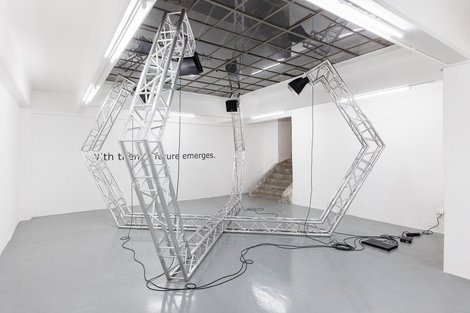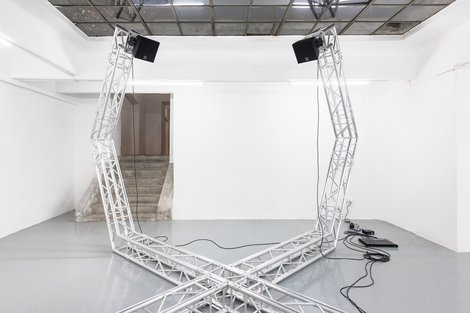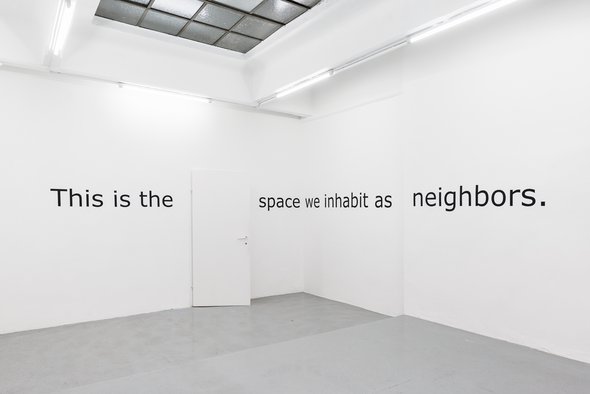The Fragiles
Barbara Kapusta
Barbara Kapusta
“BECOMING NEIGHBORS
AND RESIDENTS,
REACHING ONE ANOTHER,
WE RELATE TO
ONE ANOTHER.”
Barbara Kapusta’s practice links poetry, sculpture and sound. In her multimedia installations, she connects thinking about human bodies with the language of the digital world and creates imaginaries of a future that oscillates between dystopia and the possibility of its restructuring.
The Fragiles consists of a sculpture reminiscent of technical structures, with arms reaching upward like tentacles. Loudspeaker boxes are attached to their ends, circulating sound around the sculpture and its immediate surroundings. Its shape traces a so-called Lévy C-curve that describes fractal systems of natural or artificial entities. In Kapusta’s work, the form employs this association to undermine linear beliefs about the future with repetitive structures, similarity, and recurring temporalities.
AND RESIDENTS,
REACHING ONE ANOTHER,
WE RELATE TO
ONE ANOTHER.”
Barbara Kapusta’s practice links poetry, sculpture and sound. In her multimedia installations, she connects thinking about human bodies with the language of the digital world and creates imaginaries of a future that oscillates between dystopia and the possibility of its restructuring.
The Fragiles consists of a sculpture reminiscent of technical structures, with arms reaching upward like tentacles. Loudspeaker boxes are attached to their ends, circulating sound around the sculpture and its immediate surroundings. Its shape traces a so-called Lévy C-curve that describes fractal systems of natural or artificial entities. In Kapusta’s work, the form employs this association to undermine linear beliefs about the future with repetitive structures, similarity, and recurring temporalities.
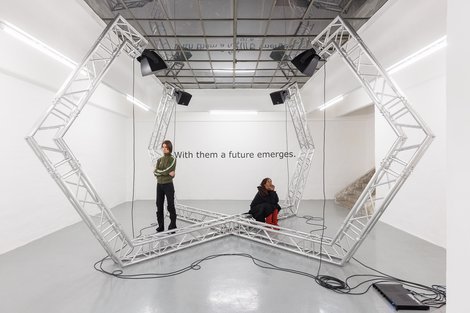
11.11.23—16.12.23
GIANNI MANHATTAN, Wassergasse 14, 1030 Vienna
> Press release> Installation views
“BECOMING NEIGHBORS
AND RESIDENTS,
REACHING ONE ANOTHER,
WE RELATE TO
ONE ANOTHER.”
Barbara Kapusta’s practice links poetry, sculpture and sound. In her multimedia installations, she connects thinking about human bodies with the language of the digital world and creates imaginaries of a future that oscillates between dystopia and the possibility of its restructuring.
The Fragiles consists of a sculpture reminiscent of technical structures, with arms reaching upward like tentacles. Loudspeaker boxes are attached to their ends, circulating sound around the sculpture and its immediate surroundings. Its shape traces a so-called Lévy C-curve that describes fractal systems of natural or artificial entities. In Kapusta’s work, the form employs this association to undermine linear beliefs about the future with repetitive structures, similarity, and recurring temporalities.
AND RESIDENTS,
REACHING ONE ANOTHER,
WE RELATE TO
ONE ANOTHER.”
Barbara Kapusta’s practice links poetry, sculpture and sound. In her multimedia installations, she connects thinking about human bodies with the language of the digital world and creates imaginaries of a future that oscillates between dystopia and the possibility of its restructuring.
The Fragiles consists of a sculpture reminiscent of technical structures, with arms reaching upward like tentacles. Loudspeaker boxes are attached to their ends, circulating sound around the sculpture and its immediate surroundings. Its shape traces a so-called Lévy C-curve that describes fractal systems of natural or artificial entities. In Kapusta’s work, the form employs this association to undermine linear beliefs about the future with repetitive structures, similarity, and recurring temporalities.
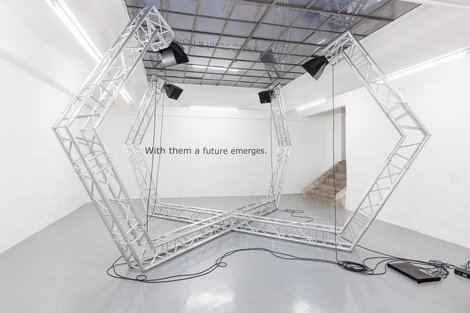
The sound piece of The Fragiles is based on a fragmentary science fiction narrative set in a world characterized by isolation, social inequality, and migration due to both climate and economy. From an apocalyptic future, the narrator looks back at the foundations on which this time is built. She speculates on the technologies of control, data collection, and the manipulation of interests, preferences, and desires, and allows temporalities to collide. Entanglements between technology and ideology, between politics and built space, between digitality and sociability become apparent.
Repeatedly, a WE / I / YOU is addressed that evades concrete identities.
Rather, the ways in which similarities and empathy are established is brought into question. This also brings into view notions of social homophily - a concept that global corporations exploit by processing complex amounts of data to categorize individuals and thus produce statements about their behavior.
Repeatedly, a WE / I / YOU is addressed that evades concrete identities.
Rather, the ways in which similarities and empathy are established is brought into question. This also brings into view notions of social homophily - a concept that global corporations exploit by processing complex amounts of data to categorize individuals and thus produce statements about their behavior.
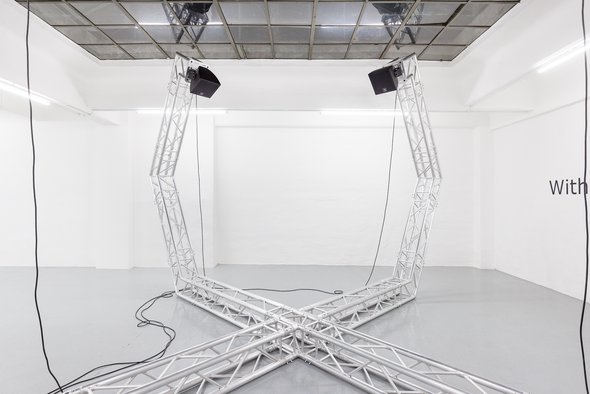
Kapusta’s work challenges dominant notions that friendships, like neighborhoods, (can) only function on the basis of shared identities, shared values, and shared beliefs. Rather, patterns of similarity and homophily appear as a complex phenomenon shaped by social and political processes like technological systems:
“As digital platforms, more or less invisibly, use homophily to guide us to people, purchases, destinations, and ideas, they help to produce a social world in which previously held identities and positions are reinforced and concentrated rather than challenged or hybridized.”
Against the backdrop of a dystopian future and ecological catastrophe, The Fragiles speculates on hybrid constellations, friendships, and relationships of closeness despite differences and contradictions. The stories told remain fragmentary and open to be assembled in multiple ways. In doing so, the artist points to the potential of contingent resonances and ways of living together that evade dominant roles as well as the promises of a capitalist logic. The personal, questions of care, the vulnerability of bodies and sensuality are just as important as the virtual and the politics of the digital age. How can living together be organized in the face of contradictions, ambivalences and diversity? And what role can technology and language play in enabling empathy and a more equitable use of given resources?
Text by Juliane Bischoff
“As digital platforms, more or less invisibly, use homophily to guide us to people, purchases, destinations, and ideas, they help to produce a social world in which previously held identities and positions are reinforced and concentrated rather than challenged or hybridized.”
Against the backdrop of a dystopian future and ecological catastrophe, The Fragiles speculates on hybrid constellations, friendships, and relationships of closeness despite differences and contradictions. The stories told remain fragmentary and open to be assembled in multiple ways. In doing so, the artist points to the potential of contingent resonances and ways of living together that evade dominant roles as well as the promises of a capitalist logic. The personal, questions of care, the vulnerability of bodies and sensuality are just as important as the virtual and the politics of the digital age. How can living together be organized in the face of contradictions, ambivalences and diversity? And what role can technology and language play in enabling empathy and a more equitable use of given resources?
Text by Juliane Bischoff
